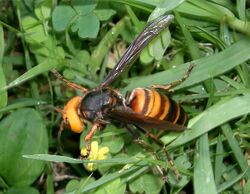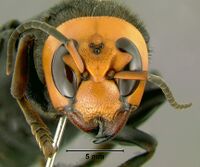Biology:Japanese giant hornet
The Japanese giant hornet (formerly known as Vespa mandarinia japonica) is a color form of the world's largest hornet, the Asian giant hornet (V. mandarinia); though formerly considered a subspecies, it has been treated as a synonym of the subspecies V. m. mandarinia since 1997.[1] It is a large insect, with adults frequently growing to greater than 4 centimetres (1.6 in) long, with a wingspan greater than 6 centimetres (2.4 in). It has a large yellow head with large eyes, and a dark brown thorax with an abdomen banded in brown and yellow. The Japanese giant hornet has three small, simple eyes on the top of the head between the two large compound eyes. As the name implies, it is endemic to the Japan , where it prefers rural areas where it can find trees to nest in.[2] In Japanese it is known as the ōsuzumebachi (オオスズメバチ(大雀蜂、大胡蜂), literally "great sparrow bee").
Description
Workers forage to feed their larvae. Their diet consists of a wide range of insects, including crop pests, and for this reason the hornets are regarded as beneficial. The workers dismember the bodies of their prey to return only the most nutrient-rich body parts, such as flight muscles, to the nest.[citation needed] There, the workers chew the prey into a paste before feeding the larvae which in return produce a fluid consumed by the workers. This fluid is known as vespa amino acid mixture (VAAM)[citation needed]. Synthetic VAAM is being produced artificially as a dietary supplement, with claims that it can increase athletic performance.[3] In many Japanese mountain villages, the hornet is considered a delicacy when fried.[2]
Bee predation
In Japan, beekeepers often prefer European honey bees because they are more productive than the endemic Japanese honey bees.[citation needed] However, it can be difficult to maintain a captive hive of European honey bees, as the giant hornets are devastating to the bee hives.[citation needed] Once a Japanese giant hornet has located a hive of European honey bees, it leaves pheromone markers around it that quickly attract nest-mates to converge on the hive. An individual hornet can kill forty European honey bees per minute, while a group of 30 hornets can destroy an entire hive containing 30,000 bees in less than four hours.[4] The hornets kill and dismember the bees, returning to their nest with the bee thoraxes, which they feed to their larvae, leaving heads and limbs behind. The honey and bee larvae are also taken to feed the hornet larvae.
Unlike their European relatives, the Japanese honey bee has a defense against the hornets. When a hornet approaches the hive to release pheromones, the bee workers will retreat back to the hive, leaving an opening to allow the hornet scout to enter. The bees then emerge from their hiding places in an angry cloud formation containing some 500 individuals.[2] They form a tight ball around the attacking hornet that acts like a convection oven with the bees vibrating their wings to generate heat via muscular exertion and then directing the air warmed around them inward to the center of the ball. This causes the interior temperature of the ball to rise to 47 °C (117 °F). Additionally, the bees' activity increases carbon dioxide concentration inside the ball. The hornet's ability to withstand heat decreases as carbon dioxide concentrations increase, ultimately causing the increased temperature to become lethal.[5]
Venom
The Japanese giant hornet is large and can be very aggressive if provoked. Its venom, which is injected by the 6.25 mm-long stinger, attacks the nervous system and damages the tissue of its victims.[2] Tests involving mice found that the venom falls short of being the most lethal of wasp venom, having an -1">50 of 4.0 mg/kg. In comparison, the deadliest wasp venom (at least to lab mice) by weight belongs to Vespa luctuosa at 1.6 mg/kg. The potency of the sting is due, rather, to the relatively large amount of venom injected.[6] Being stung is extremely painful and can require hospitalization. Asian giant hornet stings can cause anaphylactic shock in allergic people but can still be lethal to people who are not allergic, provided the dose is sufficient. In China, where the hornet can also be found, the conventional wisdom is that people stung more than 10 times need medical help, and emergency treatment if stung more than 30 times. The stings can also cause kidney failure.[7] Thirty to forty people die in Japan every year after having been stung by bees and wasps (including the Japanese hornet).[2][8]
References
Notes
- ↑ James M. Carpenter; Jun-ichi Kojima (1997). "Checklist of the species in the subfamily Vespinae (Insecta: Hymenoptera: Vespidae)". Natural History Bulletin of Ibaraki University 1: 51–92. http://research.amnh.org/iz/f/Carpenter_Kojima_1997_ves.pdf.
- ↑ 2.0 2.1 2.2 2.3 2.4 Ross 2007, pp. 9–11
- ↑ "VAAM Energy: Vespa Amino Acid Mixture Metabolize Fat Into Energy". http://www.vaam-energy.com/.
- ↑ "30 Japanese Giant Hornets kill 30,000 Honey Bees". https://www.youtube.com/watch?v=EZ1eAM8CChc. Retrieved 4 September 2019.
- ↑ Sugahara & Sakamoto 2009
- ↑ Schmidt et al. 1986
- ↑ Branigan, Tania (26 September 2013). "Hornet attacks kill dozens in China". The Guardian. https://www.theguardian.com/world/2013/sep/26/hornet-attacks-kill-18-china.
- ↑ According to "わが国における蜂刺症 The Topic of This Month Vol.18 No.8(No.210) 国立感染症研究所", fatalities from bees and wasps are 30-40 annually in Japan (including hornets).
Sources
- Schmidt, Justin O.; Yamane, Soichi; Matsuura, Makoto; Starr, Christopher K. (1986). "Hornet venoms: Lethalities and lethal capacities". Toxicon (Elsevier) 24 (9): 950–954. doi:10.1016/0041-0101(86)90096-6. PMID 3810666. http://www.ckstarr.net/cks/1986-VENOM.pdf.
- Sugahara, M.; Sakamoto, F. (2009). "Heat and carbon dioxide generated by honeybees jointly act to kill hornets". Naturwissenschaften 96 (9): 1133–1136. doi:10.1007/s00114-009-0575-0. PMID 19551367. Bibcode: 2009NW.....96.1133S.
- Ross, Piper (2007). Extraordinary Animals: An Encyclopedia of Curious and Unusual Animals. pp. 9–11. ISBN 978-0-313-33922-6. https://archive.org/details/extraordinaryani0000pipe/page/9.
Wikidata ☰ Q2051025 entry
ja:オオスズメバチ




